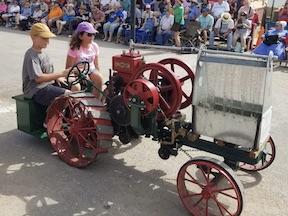
“I love those early 1900s steel wheel gas tractors like the Rumely Oil Pull, Fairbanks Morse 15-25 and the International friction drive, but they’re rare and expensive to own, so I decided to build my own mini tractor,” says Shawn Strunk, a Wichita, Kan., machinist and manufacturing engineer.
Strunk began without specific drawings but had planned it all out in his mind, knowing he’d use an Economy 1.5-hp. hit-and-miss engine, built in 1920 and sold by Sears Roebuck, to power his scaled-down tractor. Strunk fabricated everything but the engine and the gears.
Six months after he started, the 1,000-lb. finished tractor, which measures 3 ft. wide by 8 ft. long, clearly resembled a model of early 1900s gasoline tractors. Now, it putts along in parades at 3 mph.
Strunk and his two children have driven it in parades in Colwich, Mount Hope and Yoder, Kan. He also shows it at Kansas threshing bees in five different towns and at the Kansas State Fair.
The tractor is built on a frame made of 3-in. channel iron. The engine is mounted mid-body, driving a working manual clutch resembling one from a Case steam engine. The transmission has one forward gear and one in reverse. Strunk says, “The clutch and sliding gear transmission probably took the most time to sort out and figure out how to build. The friction clutch uses two “shoes” made from Basswood that engage inside the clutch drum. Power is transferred from the clutch to the transmission via a large roller chain.”
The tractor has a differential from a Deere 110 garden tractor that transfers the motion to each rear wheel. The bull gears are from a Stover water well pump jack.
Strunk made the wheels out of oil field pipe on his shop-built turntable, powered by a variable-speed gear motor. This allowed him to position a plasma torch to slice the wheels to the desired width.
The rear wheels are 24 in. in diameter by 7 in. wide, and the front wheels are 16 in. in diameter. He used the same jig to make the center hub and weld in the steel spokes. The wheels have rubber treads to resemble lugs on the rear and bands on the front, so they won’t damage concrete or paving while driving.
Strunk built the operational screen cooler radiator and tank out of sheet metal, installing a hand-built piston pump machined out of brass and copper. He says it cools the engine very well and adds detail to the tractor, similar to large radiators on full-size tractors.
The wood bunkers on the tractor’s rear serve as seats and hold the ignition battery and supplies such as oil and grease. Steering is done with a shaft that extends to a worm gear below the tractor’s frame. That turns a chain roll shaft running width-wise under the frame. Strunk says many early gas and steam tractors used this type of steering. The steering wheel is an old hand wheel from a J.I. Case threshing machine.
Strunk says the engine has a simple make-and-break ignitor, which was common before the modern spark plug. Two electrodes inside the cylinder mechanically make contact via the engine exhaust push rod and charge up the ignition coil. The points rapidly release to create a hot spark and ignite the fuel. He starts the engine by spinning the flywheels while choking the air intake to draw fuel into the cylinder. “Once it’s primed, it takes just one or two pulls on the flywheels to get it started,” Strunk says.
A black pipe funnels the engine’s exhaust up and away from the driver. “The engine makes a very nice heartfelt thump and hums along very smoothly,” Strunk says. He and his kids love driving it, and paradegoers find the small tractor fascinating.
Contact: FARM SHOW Followup, Shawn Strunk, Colwich, Kan. (inventive.machine77@gmail.com).
